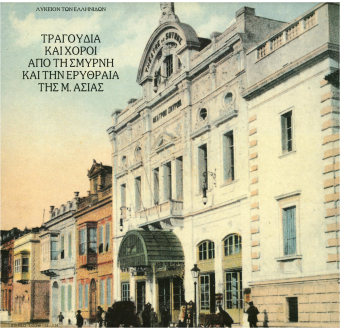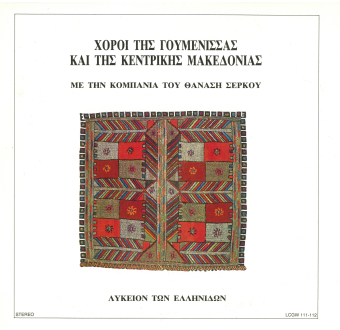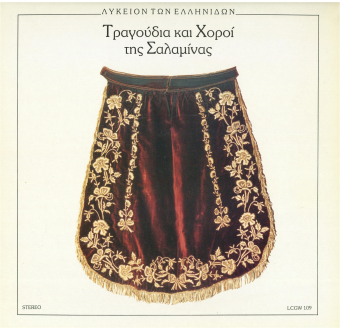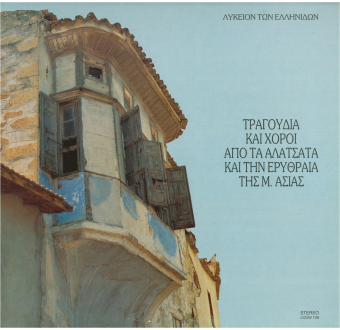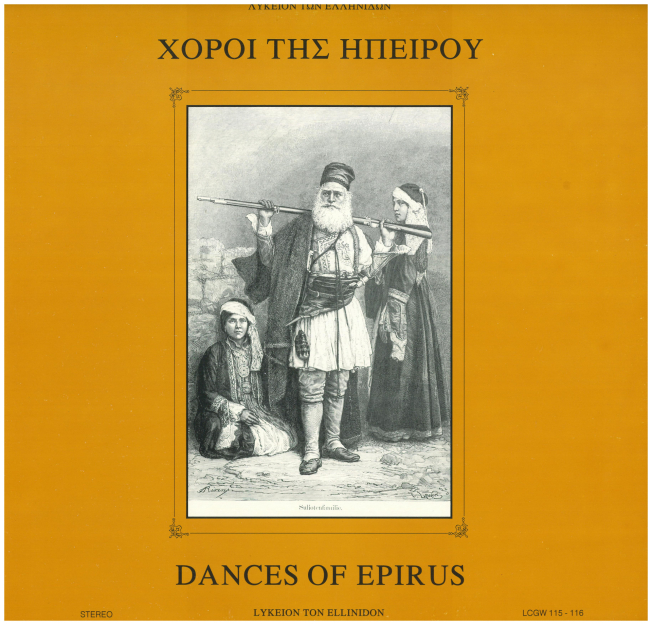
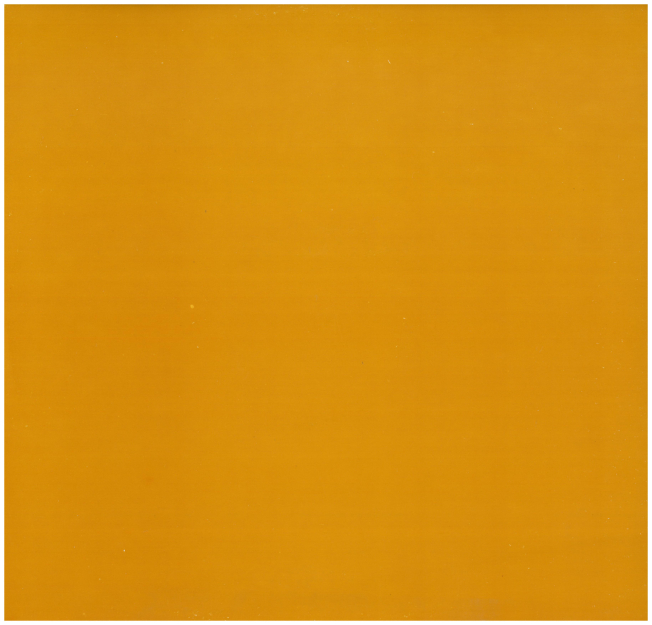
The series of records issued by the Lyceum Club of Greek Women of Athens, under the title: Folk Music - Dances-Songs, has not, to date included a satisfactory number of dances belonging to the Epirot musical tradition (1).
The recordings we present today are not very recent. They were made in 1988, in order to supply an obvious lack in this particular series. It has now been made possible to issue these two discs (Nos. 115 and 166), which still, however, contain only a small sample out of the rich musical folk heritage of Epirus. Some of these melodies have become widely popular in Greece, and some of the dances (such as the Fyssouni, for instance) have acquired an almost panhellenic character, thanks to their frequent performance by various folk dance groups.
The material presented here is necessarily fairly limited in range, in spite of the efforts we have made to render it as representative as possible. We hope to be able soon to bring out a new record in this series, with songs and dances of smaller communities of Epirus, in accordance with what we have endeavoured to do, so far.
However, the Epirot dance tradition is so rich that it would require a great number of dics to even attempt to cover the entire range. Thus, for instance, in these records we have been forced to omit certain songs and dances which are performed on special occasions and which, for the most part, belong to very small communities. Fortunately, in recent years, there have appeared many noteworthy editions of the music of Epirus, so that those who are particularly interested in this wonderful area of the Epirot musical and dance repertoire will be able to find a good number of excellent recordings.
The pieces contained in these discs belong to the wider musical and dance repertoire which we may term pan-Epirotic, even though some of the tunes are known to the Epirots themselves- and especially to the musicians who perform them- by names indicative of their particular place of origin (such as Argyrokastritiko - dance of Argyrokastro, for example). As, however, they are in use in very wide areas, we may say that they are of a pan-Epirot character.
Today, what we may - somewhat arbitrarily perhaps - call typically Epirotic, from the point of view of the music and the dance, mainly pertains to an area delimited by the prefectures of Ioannina (including the villages of Dropolis, in Northern Epirus, across the Albanian border), of Thesprotia and of parts of the prefectures of Preveza and Arta; in short, to the regions influenced by the great urban centre of Ioannina. The prefectures of Preveza and Arta do, indeed belong to Epirus, however large sections of these two prefectures come under the influence of the cultural tradition of Roumeli, and their repertoire, therefore, cannot be considered entirely characteristic of Epirus. The variety of form found in both the dance and the music of Epirus - let us not forget the marvellous polyphony in the songs of some villages of the Pogoni region and of Northern Epirus - is very great. On the whole, however, so far as the dances are concerned, we may observe that they follow a slow, grave rhythmical pattern. It can be said that here in Epirus, the term “vary’s” -heavy- attains its full meaning, a meaning which a stranger cannot easily grasp. Although the term “heavy” does indeed apply to the slow pace of the rhythmic pattern, it also describes the expression, the manner in which the dance is performed. The technique of the movement pattern is subordinated to the dominating “heavy” style of expression, which stems from an inner intensity, and which endows the dance and dancers with a majesty which is remarkable and unparalleled.
Another trait which characterizes the music of almost the entire Epirus region is the “gyrismata”, the “turns”, or changes, executed by the instrumental ensemble following the initial dance or song performed by the first dancer as he leads his family group or his company of friends in their evolutions. These gyrismata are used by all the musical “companias” and, unless the leader express some other desire, the players will follow the same “turns”, in more or less the same order, in accordance with the oral tradition which has been shaped and handed down through the years. For instance, if a dancer leading the Zagorissios does not specifically ask for some other “turn”, the players will naturally and automatically go into a Tsamikos and, following that, into a smooth Pogosinissios. Concerning this category of Epirot music, Pantelis Kavakopoulos writes (2): “With the passing of the years, some of the instrumental “turns” acquired a particular form as regards melody, metre and tempo. To embellish and add variety to these “turns”, the folk players fitted to the metre and tempo of the tune various love couplets of 11, 13 or 16 syllables… such as:
Rosy apple mine, Janniot form so fine …
or Duckling of the sea, love no one else but me ... and others“ .
These “turns”, instrumental or sung, together with the original melody of the dance compose a musical or dance “suite”, and constitute one of the most interesting elements of the Epirot musical tradition.
It is not easy, in a recording, to render the musical evolution of a festive occasion, in which the main dance and song are followed by these gyrismata in the melody and movement which lend an added intensity to the act of the dance. Neither can it achieve the reciprocal communication established during the “live” event between players and dancers, since the latter are absent during the recording. Moreover, it is impossible to reproduce the duration of a “glendi”, or festive celebration, since the time allowed for the recording of a dance or song is almost always limited. The immediate and vivid relationship, therefore, established between players and dancers in an Epirot gathering or panegyri, which often develops into a popular artistic musical and dance creation, is inimitable and unique.
The dances of Epirus follow the usual semicircular formation. The dancers are placed either in two concentric semicircles, with the women in the inner semicircle and the men on the outside (the contrary occurs rarely), or in one semicircle in which the men occupy the first places and the women follow. These forms do not apply today, since customs, even in the smallest of villages, have changed and the dance order of the past is no longer taken into consideration. In the indoor places, where today’ s gatherings are mainly held, the Epirots dance by families or friendly companies. The mixed dance, that is, where men and women alternate in the same circle, without regard to order, is the predominant form here, as in the rest of Greece. At weddings, however, or in villages where certain traditional “dance-dramas”, such as the dances of the “Kangelaris”, are still preserved, the old order is religiously adhered to.
Face-to-face dances are not found in Epirus, except for the syngathistos dances performed in the Vlach villages of the mountains, or, as Pantelis Kavakopoulos delimits the area: “along the mountain crests of Pindus, from Fourka to Metsovo and the villages of the Aspropotamos” (3).
The clarinet is the musical instrument which, par excellence, has represented Epirus for the past 150 years; ever since the time, that is, of its appearance in Greece. With the passing of the years, a special tone colouring has been developed in the playing of the good Epirot clarinetists, one that is very characteristic, entirely distinctive and easily recognizable among those of the other Greek regions. The clarinet forms the basis of the Epirot musical compania, which is complemented by the violin, the lute and the defi (tambourine). Markos Dragoumis, in his comments on the music of Epirus, says that “the playing of the musicians is quite distinctive, as they use various embellishments, such as glissandi and other technical effects characteristic of the local virtuosity, as they give prominence to the low tones on their clarinet, in preference to the high tones, and as they resort to the use of scales in which the semitone is missing…” (4).
Here, two clarinet players of established fame, Napoleon Damos from Kourenta, Ioannina, in disc No. 115, and Grigoris Kapsalis, from Elafotopos, Zagori, in disc no. 116. with their fellow-players of that period (1988), play and sing some very characteristic dance tunes.
March 1994
Lefteris Drandakis
(1) Only LP No. LCGW 110, entitled “Twelve Dances", includes two Epirot songs, performed by the same “compania” appearing in these discs. Also cassettes Nos ΛΤΕ 008 and ΛΤΕ 009, contain some Epirot dances from the same recording, but without comments.
(2) Pant. Kavakopoulos: Instrumental turns in the folk song. Report of the 4th Folk Symposium of the Northern Greek Area. Edited by the ΙΜΧΑ (Institute of Studies of the Almos Peninsula), Thessaloniki 1983, p.26
(3) Pant. Kavakopoulos, op. cit. p.57
(4) M. Dragoumis: Comments on record “Epirotica 1926 - 1950”, Falirea No.401.
LCGW 115
With the company of NAPOLEON DAMOS
Side A
1. Perdika (Instrumental) 3.08
2. Fengari mou lambrotato (Vocal) 2.45
3. Heavy berati (Instrumental) 2.52
4. Old kleftes (Vocal) 3.52
5. Double gaida or Gaida (Instrumental) 4.07
6. Arvanitiko (Instrumental) 3.30
Side B
1. Halassia mou (Couplets) 4.37
2. Karapataki (Instrumental) 2.46
3. Xenitemeno mou pouli (Vocal) 2.45
4. Smantakas (Vocal) 4.08
5. Fyssouni (Instrumental) 2.20
6. Lemonia or Vissaniotissa (Vocal) 4.08
The melodies heard on this record are played by Napoleon Damos and his "compania", consisting of the following:
Clarinet: Napoleon Damos
Violin: Evangelos Gogos
Lute-Song: Lambros Halkias
Defi: Yiannis Kottas
LCGW 116
With the company of GRIGORIS KAPSALIS
Side A
1. Karapataki (Instrumental) 3.30
2. Sti vrissi sta Tseritsiana (Vocal) 4.53
3. Argyrokastritiko (Instrumental) 3.43
4. Fezodervenagas (Instrumental) 3.00
5. Kostandas (Instrumental) 3.23
6. Berati (Instrumental) 3.15
Side B
1. Daliana (Vocal) 3.30
2. Genovefa (Instrumental) 3.50
3. Frassia (Instrumental) 3.07
4. Thiakos - Selfo's song (Instrumental) 1.56
5. Arvanitovlachikos - Poulia petoumena (Instrumental) 2.45
6. Kalatzis (Instrumental) 1.50
7. Menoussis (Instrumental) 1.53
8. Old zagorissios (Instrumental) 2.20
The melodies heard on this record are played by Grigoris Kapsalis and his "compania", consisting of the following:
Clarinet-Song: Grigoris Kapsalis
Violin: Theodoros Dimou
Lute: Antonis Markopoulos
Defi-Song: Yiannis Kottas
LCGW 115
With the company of NAPOLEON DAMOS
Clarinet: Napoleon Damos
Violin: Evangelos Gogos
Lute-Song: Lambros Halkias
Defi: Yiannis Kottas
LCGW 116
With the company of GRIGORIS KAPSALIS
Clarinet-Song: Grigoris Kapsalis
Violin: Theodoros Dimou
Lute: Antonis Markopoulos
Defi-Song: Yiannis Kottas
The dances on LPs LCGW 115-116 were recorded in Athens, at the ERA STUDIO, in November 1985 on an AMPEX AG 440 C tape recorder.
Recorded by: Yiannis Sygletos




